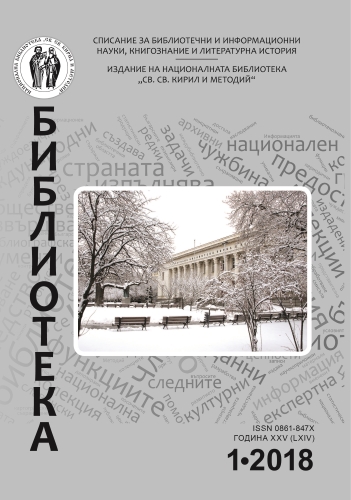Сeмиозис на Умберто Еко Нишката на Ариадна и личността в лабиринта на информацията: Кадастър на универсалното знание
The semiosis of Umberto Eco The Ariadne’s thread and the personality in the labyrinth of information: Cadastre of the universal knowledge
Author(s): Alexandra KumanovaSubject(s): Essay|Book Review |Scientific Life
Published by: Национална библиотека »Св. св. Кирил и Методий«
Keywords: Umberto Eco (1932–2016): semiosis – noosphere; semiosphere; infosphere and bibliosphere; structured forms; humanitarian dimensions; naming of the information realities; information rhizome;
Summary/Abstract: It is determined the presence of Umberto Eco in the national cultures as a trace in the noosphere, semiosphere, infosphere and bibliosphere of the Mankind because through it is following up the capacity of the interactions in these fields (W. Wundt, W. Dilthey, W. James, G. Simmel, J. Dewey, J. H. Mead, R. E. Park, H. G. Blumer, M. M. Bakhtin, S. Denchev). The semiosis of Umberto Eco reveals the geocosmic confines of the single cultural-information acts of the reality and consciousness. That, we are trying to describe, is realized according to Umberto Eco in structured forms.It is clarified that the idea of humanitarian dimensions of the information modeling introduces in the world of the information reality and science the field of humanitarian knowledge, synthesized on the ground of the names of the information realities, arranging these same realities (St. Gregory the Theologian – Nazianzen, Proclus Lycaeus – the Successor, …, F. Schleiermacher, W. Dilthey, M. Heidegger, A. F. Losev, A. A. Taho–Godi).Namely the humanitarian dimensions are comprehensible for many people in the sense that they mean in the cited names and sustainable images connected to them. This structuring represents practically plenary freedom of the man in the information space: planning and realization of the retrieval and rationalization of the information, owing bibliographic and historiographic accumulations in the noospheric firmament of the Mankind as connections among things.It is shown that the relations among objects are realized through the information rhizome – a mental formation of realities communication in their geocosmic confines, defined by Umberto Eco as “struttura assente” (“absent structure”). The information rhizome is the root of the “living substance” (V. I. Vernadskiy) by virtue of the universalism achieved in the works of Umberto Eco. This universalism is analogical to the universalism of the architects of cosmism which is: religious and philosophical-religious (sacred Vedas, Avesta, Upanishads, Quran; thinkers of the Western culture who synthesize the majestic roads of ideas development – R. Descartes, B. Spinoza, G. W. von Leibniz, I. Kant, G. W. F. Hegel, F. W. J. von Schelling, A. Schopenhauer, E. G. A. Husserl, M. Heidegger, G. Deleuze, …, as well as East European, Russian cosmists – A. S. Homyakov, V. S. Solovyov, N. K. Ryorih, S. N. Bulgakov, S. L. Frank, N. A. Berdyaev, P. A. Florenskiy, L. P. Karsavin, I. A. Ilin, B. P. Vysheslavtsev, I. S. Kon, A. F. Losev; ... J. Campbell, M. Eliade, H. Corbin…); scientific (… Empedocles, Democritus, …, J. Kepler, I. Newton, M. Plank, A. Einstein…); theoretical (A. F. Fedorov, V. I. Vernadskiy, P. Teilhard de Chardin, E. Le Roy, N. A. Umov, N. D. Kondratiev, A. L. Chizhevskiy, L. A. White, A. A. Lyubishchev, S. V. Mein, V. P. Kaznacheev, A. I. Subeto; A. E. Akimov, G. I. Shipov, B. I. Iskhakov…); practical (… Hippocrates, … Galenus, ... Ibn Sina /Avicenna/, ... N. I. Pirogov, A. Schweitzer…, N. Yaramov…); humanitarian (M. M. Bakhtin, L. N. Gumilyov, V. I. Ivanov, A. F. Losev, Y. M. Lotman, Y. A. Shreider); natural-scientific (from the astronomers of the ancient world – Arktida (Hyperborea), Elam, Akkad, Sumer, Iran, China, India, Egypt, Babylon, Arab-Muslim world, Central and South America, … to the great names of the human civilization – Archimedes, N. Copernicus, G. Galilei, J. Kepler, I. Newton, M. V. Lomonosov, N. I. Lobachevskiy, D. I. Mendeleev, S. A. Podolinskiy, ... A. Einstein…); scientific-technical (K. E. Tsiolkovski, S. P. Korolev…); bibliographic (Callimachus of Cyrene, C. Gessner, P. Labbé, A. Teyssié, E.-G. Peignot, J. Petzholdt, A. G. S. Josephson, W. Grundtvig, J. Vorstius, T. Besterman, …, N. Mihov, T. Borov…; G. Schneider, L.-N. Malclѐs, K. R. Simon; A. Taylor, I. V. Gudovshchikova, A. Kumanova…).The described rhizome displays the interactivities between the representatives of the literary cosmism (Homer, Dante Alighieri, William Shakespeare, Hong Zicheng (Hung Tzu-Cheng), J. W. von Goethe, A. S. Pushkin, F. I. Tytchev, F. M. Dostoyevski, L. N. Tolstoy, A. P. Chekhov, V. I. Ivanov, A. A. Blok, L. N. Andreev, M. A. Bulgakov). It is revealed the noospheric (semiospheric) foreseeable future of any single act of the reality and consciousness of man which is observed (by HIM and by OTHERS) in different various – universal in their maximum – connections and relations disclosed in the history and in the present where the fiction and the art establish universal models.It is indicated that through the observed labyrinth of rhizome links the man fall into the natural situation of a real information and communication choice because it activates the dialogue involution – evolution which occurs in the womb of personality (inculturation).
Journal: Библиотека
- Issue Year: 2018
- Issue No: 1
- Page Range: 53-66
- Page Count: 14
- Language: Bulgarian

